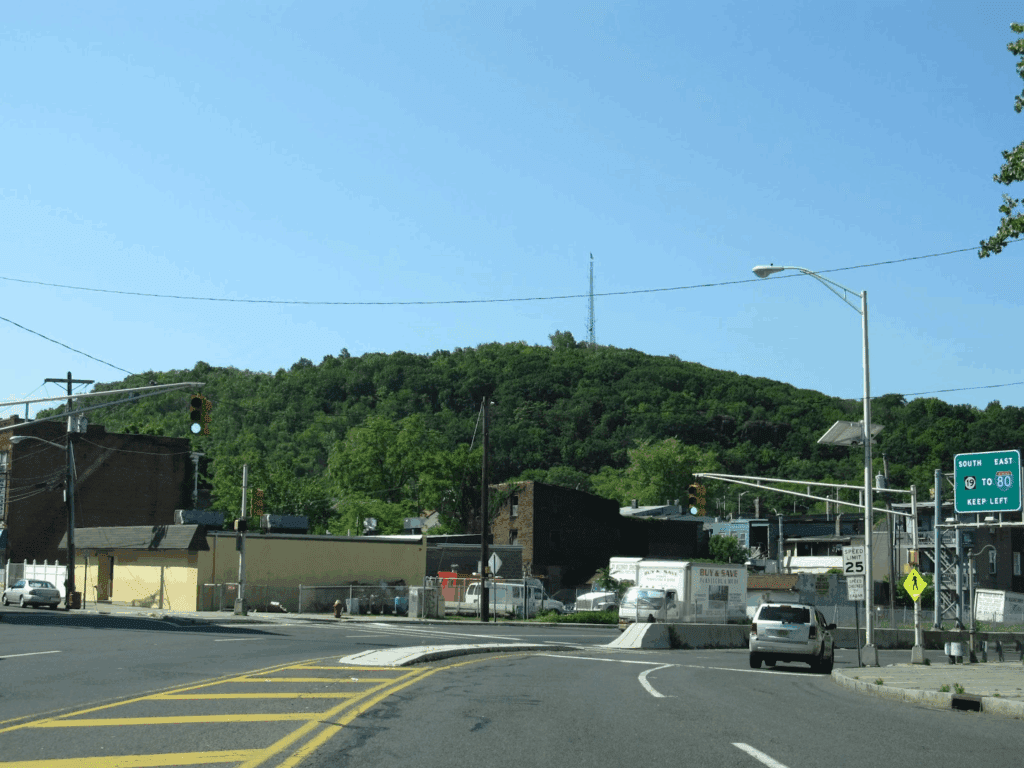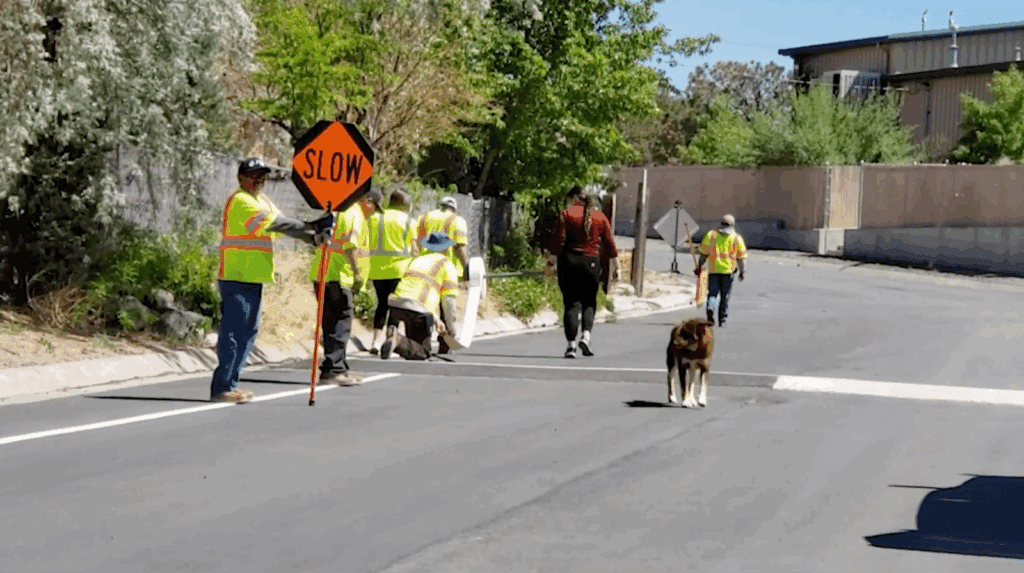Para leer este blog en español, haga clic aquí.
To read the longer version of this blog, click here.
By Misty Klann
When we think about walkability, we often focus on physical surroundings — the streets, public spaces, and amenities that make walking and rolling safe and accessible. However, for those who feel exposed or unsafe due to intolerance, harassment, or threats of violence, walkability is denied. In this blog series (read our introduction here), we explore the ways social, cultural, economic, and political factors affect the right of all people to move freely and safely in their communities.
Mobility justice is a framework that examines and seeks to address historical and ongoing transportation and infrastructure inequities that disproportionately affect marginalized communities. America Walks supports a vision for a world rooted in social justice where people feel safe existing on the streets and can build lives experiencing the full joy of movement and community regardless of their identities. We believe this is essential to promote the health, well-being, and success of our communities.
Freedom of movement is a concept transportation professionals know well. It’s the simple ability to get from Point A to Point B, whether by walking, biking, driving, or taking transit. The job of planners, policymakers, and other decision makers is often to build the physical infrastructure that makes this possible. However, true freedom of movement for all people in all communities requires us to look beyond asphalt and concrete. For many, this fundamental liberty is deeply constrained by complex societal factors.
In this entry of our Freedom to Move series, we explore how the crisis of Missing and Murdered Indigenous Women and Girls (MMIWG) represents a profound violation of freedom of movement that is rooted in historical and ongoing injustices. This is not just a concern for Native Nations; it’s a shared responsibility that transportation professionals, policymakers, and elected officials must understand and address.

The Enduring Strength of Native Women
Within many Tribal Nations, women are the very core of community life. In these matrilineal societies, women are not just caregivers; they are revered as leaders, decision-makers, healers, and keepers of essential knowledge. Their strength and resilience are integral to the well-being and prosperity of their people, with lineage, power, and respect often flowing through the maternal line. As the Cheyenne proverb says, “A nation is not conquered until the hearts of its women are on the ground. Then it’s finished; no matter how brave its warriors or how strong their weapons.” This highlights the profound cultural significance of women as the lifeline of their communities.
However, this strength often comes with a heavy burden. Native women carry the weight of historical and intergenerational trauma. The immense responsibility to be strong and provide for their families can mask deep suffering, creating barriers to seeking help. When violence disproportionately targets Native women and girls, it’s not just an individual criminal act. It is a direct assault on the cultural, social, and spiritual fabric of entire Tribal Nations. The disappearance or murder of a woman in these communities constitutes a systemic effort to dismantle Native American communities by attacking their core. This form of violence is so devastating that the National Inquiry into MMIWG in Canada explicitly concluded it constitutes an ongoing “race, identity and gender-based genocide.”
The Unrelenting Crisis: Missing and Murdered Indigenous Women and Girls
The reality for Native American women is grim. They are more than twice as likely to experience violence as any other demographic in the U.S., and on some reservations, the murder rate is 10 times higher than the national average. Despite making up only about 2% of the U.S. population, Native people are alarmingly overrepresented in missing and murdered cases.

A significant challenge in addressing this crisis is the profound lack of accurate data. The number of missing and murdered Native women and girls cannot be accurately determined due to major issues in data collection across state, local, Tribal, and federal law enforcement agencies. For instance, in 2016, the National Crime Information Center reported 5,712 missing American Indian and Alaska Native women and girls, but the U.S. Department of Justice’s federal database only logged 116 cases. This massive discrepancy represents a profound form of systemic invisibility. When cases are not properly recorded or investigated, perpetrators often face “little, if any, consequences,” creating a cycle of impunity that further endangers Native women. This lack of data directly hinders justice and prevents accurate resource allocation. How can we build “walkable, equitable, and accessible places” if the very people most at risk are not even accurately counted or recognized within the systems designed to protect them?
A Legacy of Dispossession and the Barriers to Safe Passage
The MMIWG crisis is a direct consequence of centuries of U.S. colonial Indian law and policies that have systematically diminished Tribal Nations’ inherent authority to protect their people. Harmful federal statutes, such as the General Crimes Act of 1817 and the Major Crimes Act of 1885, divested Tribes of authority over crimes on their own lands. This created a complex “maze of injustice” that has resulted in perpetrators facing little to no consequences for their actions. This historical context reveals that the crisis is a form of state-sanctioned violence, and effective solutions must involve the reclamation of Tribal sovereignty, self-determination, and self-governance.
For transportation professionals, these historical and social barriers have a direct, tangible impact. Physical infrastructure, while intended to facilitate movement, can become a source of profound danger. Major highways frequently divide Tribal communities and often lack basic accommodations like sidewalks, lighting, or shoulders. The simple act of walking to clear one’s head can be a risk without a safe, designated space.
Furthermore, the lack of public transit is a significant contributing factor to the violence experienced by Native women and girls. The absence of safe and affordable transportation is directly recognized as a “pathway to violence.” Without reliable transit, people are unable to escape dangerous situations. The prohibitive cost and distance of travel to legal aid, investigators, and courts create substantial delays and interfere with the pursuit of justice for victims. The lack of cell and internet service in many rural areas further exacerbates the danger, leaving individuals isolated and vulnerable. Areas lacking robust, safe, and affordable transportation infrastructure become transportation deserts that actively amplify vulnerability to violence.

Pathways to Healing and Safety
The path to addressing the MMIWG crisis and restoring freedom of movement requires a comprehensive approach. This journey must be rooted in culturally responsive mental health and support. Healing needs to be culturally unique and appropriate to individuals, families, and communities, extending beyond conventional counseling to include community-based emotional support and cultural services that cover the cost of accessing Elders and traditional healers. A trauma-informed approach is paramount, one that acknowledges intergenerational trauma and actively avoids retraumatizing those seeking help.
Improving transportation infrastructure is also a critical part of this healing journey. We can achieve this by integrating MMIWG safety into every stage of project development through a Vision Zero approach. Vision Zero is a global movement aimed at eliminating all traffic fatalities and serious injuries. Its core principles — that all deaths are unacceptable and preventable, that humans are vulnerable, and that responsibility is shared — can be directly applied to the MMIWG crisis.
Applying this framework to MMIWG means extending the goal of “zero deaths and serious injuries” to encompass violence against Native women and girls. We must shift responsibility from the individual to the designers of the system. This means we, as transportation professionals, have a crucial role to play in advocating for infrastructure and policies that proactively protect Native women and girls. We can develop specific goals and criteria for projects that explicitly address MMIWG safety, track their effectiveness, and leverage this data for grant submissions. Involving internal and external partners like health and emergency management departments is also key. This approach reframes the crisis not solely as a criminal justice issue, but as a public safety and systemic design failure akin to traffic fatalities.
Walking Towards a Safer Future for All
The MMIWG crisis is a profound violation of the freedom of movement and a national crime pattern that continues to dehumanize Native peoples. Despite centuries of oppression, the resilience of Native women and communities remains a powerful force.

The vision for MMIWG is to create a culturally relevant freedom of movement for the safety and well-being of all Native peoples to dream. This aligns powerfully with the principles of Vision Zero, which advocates for a future where violence is unacceptable and preventable, and where responsibility is shared. This journey requires a collective commitment, but it is not achievable without the protection and exercise of Tribal sovereignty by Tribal leaders. To make our communities truly walkable and equitable, we must do more than just build roads and pathways. We must also dismantle systemic racism, address socioeconomic vulnerabilities, and ensure access to comprehensive, culturally appropriate services. By understanding the systemic nature of the MMIWG crisis and advocating for policies that prioritize the safety, equity, and cultural integrity of Native communities, we can ensure every individual has the fundamental freedom to move, thrive, and live without fear.
Misty Klann, an enrolled citizen of the Navajo Nation, is the Principal Owner of Bluecorn Consulting, LLC, where she leverages her extensive experience in transportation planning to empower Tribal Nations. Previously, she served as a Consultative Planner for the Federal Highway Administration’s Federal Lands Highway Office of Tribal Transportation, where she guided consultation and coordination efforts with Tribal Nations while leading initiatives to strengthen Tribal transportation planning capacity.
Resources for Indigenous Communities:
- Federal Highway Administration Vision Zero Toolkit (2024)
- Urban Indian Health Institute Missing & Murdered Indigenous Women & Girls Report: A Snapshot of Data from 71 Urban Cities in the U.S. (2018)
- National Inquiry into Missing & Murdered Indigenous Women & Girls, Reclaiming Power & Place: The Final Report (Canada, 2019)
- U.S. DOJ National Institute of Justice Violence Against American Indian & Alaska Native Women & the Criminal Justice Response (2008)
- Native Hope Missing & Murdered Indigenous Women
In case you missed the previous pieces in this series, you can find them here.